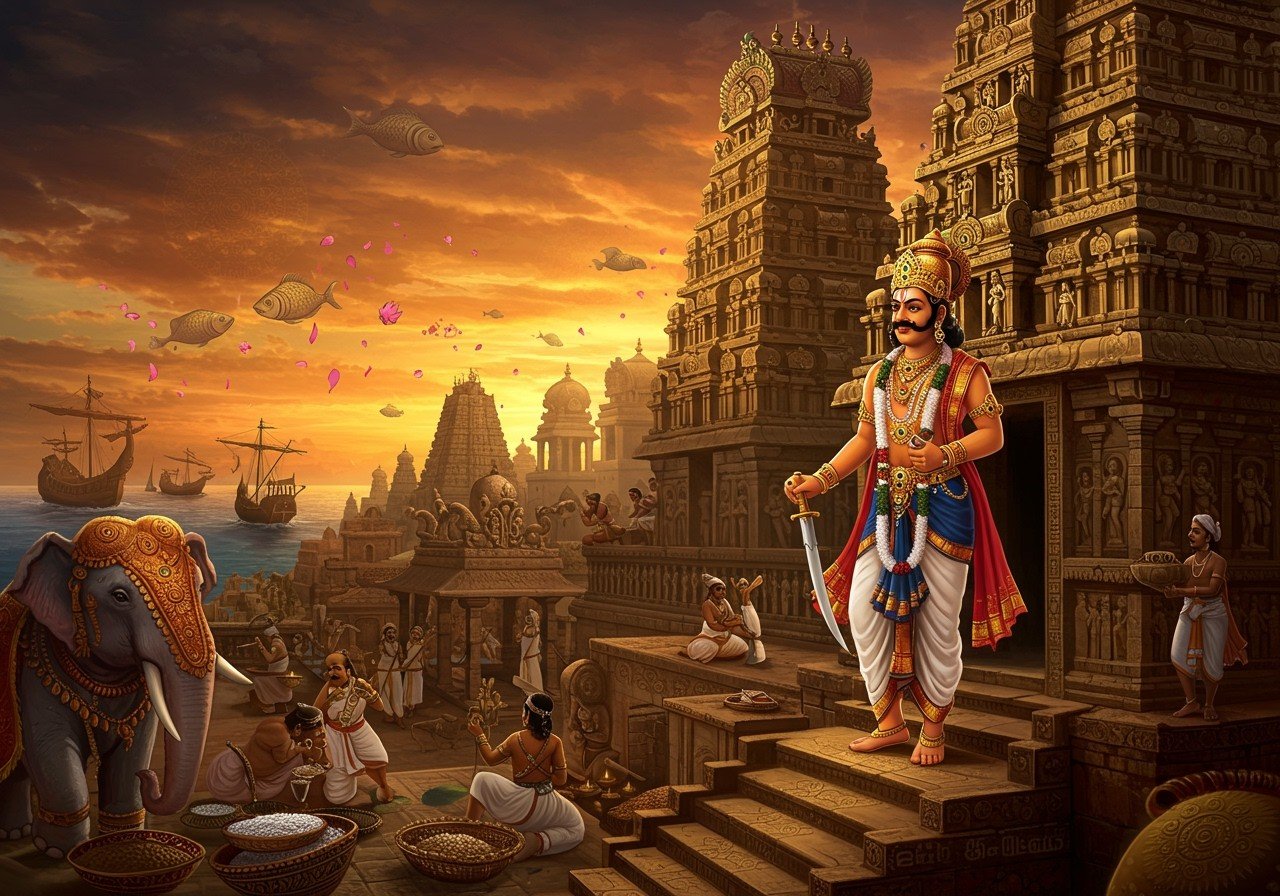The Pandya Dynasty: Rise and Fall – A Complete History

The Pandya Dynasty, a prominent ancient Tamil dynasty of South India, reigned from at least the 4th-3rd centuries BCE to the 16th century CE. Alongside the Cholas, Cheras, and Pallavas, they were one of the four great kingdoms of Tamilakam. This blog post delves into the origins, ascendancy, and eventual decline of the Pandya Dynasty, emphasizing its significant contributions to Indian history. This exploration will resonate with culturally rooted, middle to upper-middle-class Indians aged 25-60 who appreciate authentic historical narratives and cherish their traditions.
Origins and Early History
The Pandya Dynasty’s roots lie in ancient Tamilakam. Sangam literature, dating back to the 3rd century BCE to the 3rd Century CE, mentions the Pandyas as prominent figures in early Tamil society, often embroiled in power struggles with neighboring kingdoms like the Cheras and Cholas. Key figures like Nedunjeliyan I, a Pandya king during the Sangam period, played a vital role in consolidating the dynasty’s authority. Establishing Madurai as their capital, the Pandyas developed robust administrative and social structures that contributed to the longevity of their rule.
The Rise of the Pandya Dynasty
The Pandya Dynasty’s rise was fueled by several factors. Strategic marriages and military conquests, led by rulers such as Kadungon (reign 6th-7th century CE) who revived the first Pandyan empire, and Maravarman Rajasimha I (reign 730-765 CE) who expanded the kingdom, expanded their territorial control. Their economic prosperity stemmed from flourishing trade connections with the Roman Empire, Southeast Asia, and China. Moreover, the Pandyas significantly contributed to temple architecture and Tamil literature, fostering the spread of Hinduism and Jainism.
Golden Age and Cultural Contributions
The Pandya Dynasty’s golden age, spanning from the 6th to the 10th centuries CE, was characterized by cultural and economic flourishing. Architectural marvels like the Meenakshi Amman Temple in Madurai stand as testaments to their achievements. Under Pandya patronage, Tamil poets and scholars thrived, enriching Tamil literature significantly. The dynasty also made notable contributions to art, music, and dance, particularly Bharatanatyam. Advancements in irrigation and agriculture further bolstered their economic stability. The Pandyas actively promoted education and established renowned centers of learning.
Challenges and Decline
Internal strife and external pressures contributed to the Pandya Dynasty’s decline. Infighting and succession disputes weakened their central authority, while invasions by the Chola dynasty, starting in the 9th century CE, further diminished their power. The Pandyas navigated complex political alliances and conflicts with the Hoysalas and the Vijayanagara Empire. Economic difficulties and natural calamities also strained the dynasty. The Battle of Talaikotta in 1565 CE, where the Vijayanagara Empire was defeated, marked a critical turning point, further weakening the Pandyas.
The End of the Pandya Dynasty
In their final years, the Pandyas faced mounting pressure. The growing influence of the Delhi Sultanate in South India led to conflicts. The establishment of the Madurai Sultanate in the 14th century CE ultimately led to the conquest of Pandya territories. Although the dynasty officially ended in the 16th century, the defeat of Maravarman Rajasimha III by the Chola King Parantaka I between 900-920 CE marked the end of their second empire and the beginning of their significant decline.
Conclusion
The Pandya Dynasty’s journey, from its inception to its decline, showcases a compelling narrative of resilience, cultural richness, and historical significance. Their early establishment in Tamilakam, strategic expansions, and the golden age of cultural prosperity left an indelible mark on South Indian heritage. Despite facing internal conflicts, invasions, and economic hardships, the Pandyas made enduring contributions to art, literature, and architecture. Their legacy, evident in marvels like the Meenakshi Amman Temple and the flourishing of Tamil literature, continues to inspire. The Pandya Dynasty’s story serves as a reminder of the importance of preserving and honoring our rich cultural traditions.
FAQs on Pandya Dynasty
What was the timeframe of the Pandya dynasty’s rule? The Pandya dynasty ruled from approximately the 4th-3rd centuries BCE to the 16th century CE.
What led to the end of the Pandya dynasty? The Pandya dynasty’s demise was caused by a combination of factors, including internal conflicts, invasions by the Cholas and the Delhi Sultanate, and the rise of the Madurai Sultanate.
What were the key achievements of the Pandya dynasty? The Pandya dynasty made significant contributions to Tamil literature, temple architecture (exemplified by the Meenakshi Amman Temple), and maritime trade with regions like the Roman Empire, Southeast Asia, and China.
Where was the Pandya kingdom located? The Pandya kingdom was primarily situated in the southern part of India, specifically the Tamil region, with Madurai as its capital.
Explore Authentic Puja Items at Poojn.in
Connect with the rich cultural heritage of the Pandya Dynasty through traditional rituals and ceremonies. Poojn.in, India’s leading online store for puja items, offers a wide selection of authentic products to enhance your spiritual practices:
- Complete Puja Samagri sets: Find everything you need for traditional ceremonies, conveniently packaged for your ease. Explore our collection.
- Brass and Copper Items: Discover a wide variety of pure brass and copper puja items, historically significant and crafted with precision. Browse our selection.
- Diyas and Deepams: Illuminate your sacred space with authentic diya and deepam holders, reflecting the rich traditions of South Indian temples. Shop our range.
- Sacred Threads and Accessories: Enhance your rituals with genuine sacred threads and other religious accessories, sourced with utmost care. Find your perfect match.
Visit Poojn.in today to discover a wide range of certified authentic puja items and experience the essence of India’s rich cultural heritage.
Kandariya Mahadeva Temple: Religious Importance and History
Badami Cave Temples: Chalukya Dynasty Architecture


